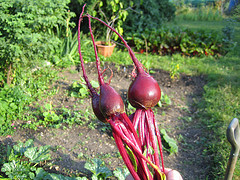Beetroot
| Infobox on Beetroot | |
|---|---|
| Example of Beetroot |  |
| Freshness facts | |
| Optimum carrying temperature | 0°C to 1°C (see text) |
| Highest freezing point | -0,5°C |
| Acceptable product temp. at loading into containers | Max. 2°C above carrying temperature |
| Optimum humidity | 95%-100% |
| Ventilation setting for containers | 10 m³/hr |
| Storage life | 2-3 weeks(bunched) 3-8 months (topped) |
| Climacteric / non-climacteric | Non-climacteric |
| Ethylene production | Very low |
| Ethylene sensitivity | Medium |
| Modified / controlled atmosphere | >5% O2; <5% CO2 |
| Potential benefits | Very little effect |
| Availability | |
| Australia Chile Cyprus France/Spain/Portugal Ireland Netherlands |
May - June December - May October - June April - June April - November On demand |
Beetroot
Contents
Harvesting and Handling
The most important of the vegetable beet is red beet, otherwise known as garden beet, table beet, or beetroot. The roots, which may be round or long, are boiled and then peeled, this procedure being necessary to avoid leakage of crimson juice. For the same reason, beetroots need to be harvested with especial care if damage, with consequential ‘bleeding’, is to be avoided.
Beets can be marketed in bunches with the foliage still intact, and in this state may be held for approx. two weeks at 0°C. More usually beets are topped (preferably not too close) in preparation for storage over a period of months. Bunched beets are much more perishable than topped beets.
There are three main hazards:
- moisture loss, which causes beetroots (especially small ones) to become flaccid and even shrivelled
- shoot growth
- decay
To minimise physiological and pathological deterioration, high humidity and low temperature are essential. For shipment of beetroots, refrigeration is necessary and it is appropriate to pack beets in polyethylene-lined sacks (with perforations). The liner must envelop all the beets since, if some remain uncovered, these will lose moisture preferentially and suffer extreme wilting.
Cooling and Storage
Bunched beets should be pre-cooled to below 4°C within 4 to 6 hours of harvest. Hydro-cooling, forced-air cooling and package icing are common cooling methods. Proper pre-cooling and packaging retard subsequent discolouration of the leaves, weight loss and decay. Mature harvested beets should be pre-cooled within 24 hours after harvest to below 5°C with forced-air cooling.
Bunched beets can be kept for about 2-3 weeks at 0°C and >95% RH. Topped beets should be stored at 1°C to 2°C and >95% RH. During storage at 0°C to 1°C, more black spot and rot occur than at higher temperatures. Red beets can be in air-ventilated storage for 4 to 6 months and in mechanical refrigerated storage for as long as 8 months. Before storage, beets should be topped and sorted to remove all diseased or mechanically damaged roots. Large roots keep much better than small ones, because they shrivel more slowly.
Death of shoots and breakdown of the top part of roots are a common problem during long-term storage of beetroots at 0°C. Physiological disorders will appear very quickly during subsequent shelf-life at 20°C. Beetroots are not sensitive to chilling temperatures and should be stored as cold as possible without freezing.
Controlled atmosphere considerations
There is little or no benefit from CA or MA storage of beetroots. Elevated levels of CO2 (>5%) in the atmosphere may cause increased decay.
Storage disorders
Bacterial soft rot, Brown rot, Rhizoctonia rot, Scab, Sclerotium rot, Watery soft rot.











